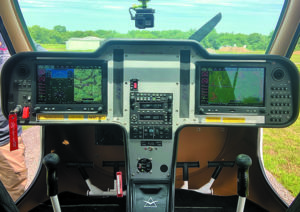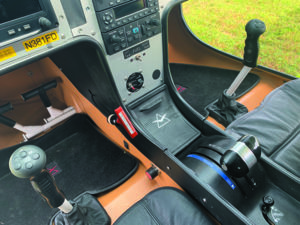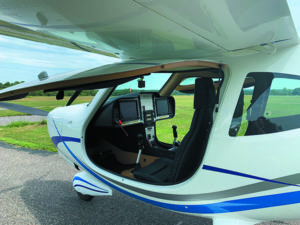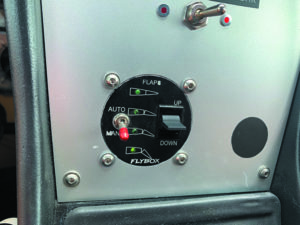If you gauge an aircraft manufacturer’s success by fleet size, I’d say that Flight Design has done pretty well, with over 2000 CT LSA models flying worldwide. And soon the German-based company will add to those numbers with its new F2.
Even in an uncertain market, at first blush the F2 caters to a variety of buyers. Since it has nontraditional LSA flying characteristics (that’s a good thing), it will likely appeal to pilots stepping down from heavier singles—Bonanzas, Centurions and even Cirrus models, to name a few. And satisfied Flight Design owners who appreciate good ergonomics, styling and field support from their airplanes might jump at the chance to put a new F2 in the hangar.

I recently flew the first preproduction F2 to hit Flight Design USA’s ramp at Woodstock, Connecticut, and found it to be the best Flight Design yet.
WALKAROUND
If you’re familiar with previous Flight Design models, the F2 will look bigger because it is. It’s wider, stands taller and has a redesigned, high aspect ratio one-piece wing that spans 34 feet, with effective pushrod-activated ailerons, plus winglets. Like the rest of the airframe, the wing is prepreg carbon fiber and constructed by the American company Hexcel. The honeycomb-cored fuselage is significantly longer than previous models.
The new wing is a major redesign because the outboard sections are separated by aerodynamic cuffs, an integral part of the F2 meeting the stringent ASTM 3180 low-speed handling standard. Flight Design USA’s Tom Peghini made it clear that this standard will apply to all Part 23 models, a certification path that the company will eventually—and aggressively—pursue with the F2. First will come EASA CS 23 and LSA certification, in the fall of 2020.
The F2’s tail is new, too. Where the older CTLS model had a full flying stabilator, the F2’s tail is a stabilizer with a discrete two-piece elevator. In the center of the elevator is a section that remains stationary with elevator deflection (beaver tail), another aid in meeting the ASTM handling requirement, and not pitching the airplane up during a departure stall. The elevator is activated with a push-pull tube that runs through the tunnel and the tail cone, and a torque tube connects the two elevator halves.
The airplane has a relatively small (but fat) rudder and high aspect ratio vertical tail. While they contribute to better slow-speed handling and spin resistance, you can still slip the F2 and have plenty of rudder authority in crosswinds. The electric flaps are operated with a control head in the center pedestal and there are three positions: Reflexed for cruise flight, neutral for takeoff and available 40 degrees of deflection for the certified airplane. Gone from the F2 is the guppy-like stubby nose that’s the signature on the other Flight Design models. The redesigned engine bay houses the fuel-injected Rotax 912iS powerplant and the cowling is considerably longer, which should make the engine easier to work on. The engine’s coolant radiator and oil cooler are housed in the cowling for lower drag and optimum cooling.
The LSA version of the F2 will have a 65-inch Neuform three-blade composite propeller and CS 23-certified models will get a composite MT prop. The Neuform on the demo airplane was a good match for the Rotax, smooth and reasonably quiet. The composite main landing gear consists of a one-piece strut and attaches to the fuselage via cushioned clamps, and the steerable nosewheel is telescoping with elastomeric springs that attach to the engine mounts.
CABIN AND AVIONICS

Flight Design models have always had fairly wide cabins and the F2 is the widest yet at 53 inches—which is actually wider than a Beech Bonanza’s cabin. And like the CTLS, ergonomics and creature comforts are good, although I wished for better ventilation on the hot day I flew the airplane. The pilot’s fresh air eyeball vent kept closing with vibration, but I give it a pass for the aircraft being a prototype. Most buyers will demand a certain level of luxury and modern interior appointments and the company has proven it can deliver that.

For cabin heat, a heat exchanger uses hot engine coolant to warm the air, which is distributed to an outlet at the base of the windshield and to the two eyeball vents on the instrument panel, while a mixing valve adjusts the temperature.
The seats are dynamically tested and meet Part 23 certification standards. The seatbacks electrically recline with a push-button in the center console and manually slide forward and aft.

In addition to the whole-airplane model 1350 BRS parachute system that’s standard on all Flight Design models, occupants have an extra layer of cushion with AmSafe airbags built into the instrument panel. The parachute has a six-year repack service interval (the propulsion rocket service interval is 12 years) and is easily accessed from a service hatch in the rear cabin.
Flight Design has replaced the Dynon SkyView HDX that worked we’ll on the CTLS with Garmin’s G3X Touch integrated avionics. It has dual 10-inch touchscreens and is interfaced with the Garmin GFC 500 autopilot, a system with sizable amounts of envelope protection and impressive control characteristics. Along with the spin-resistant wing, the beaver tail and rock-steady pitch and roll handling, F2 pilots will have to try pretty hard to get into trouble with the GFC 500’s servos working in the background even when the autopilot isn’t engaged. There’s also a Level button to get things right side up should it get that sporty.
The demo airplane had a basic stack of radios, including a Garmin audio panel and intercom, a GTR 225 VHF comm radio and a GTX 345 ADS-B transponder, which feeds weather and traffic to the G3X Touch screens. Buyers will have the option of adding Garmin panel navigators and the certified airplane will be approved for IFR in IMC. As standard the G3X Touch has charting, Bluetooth connectivity and a built-in VFR GPS.
The instrument panel is refreshingly clean, with rocker switches for lighting, generator, fuel pump and battery on the left of the pilot’s panel. Circuit breakers are over on the far right. The aircraft uses a single EarthX lithium battery (dual batteries will be optional) and the Rotax has dual internal generators—one 16-amp generator for running the engine’s electronics and a 30-amp generator to power the aircraft systems.
The ECU (engine control unit) handles all power distribution, and a guarded switch on the pilot’s panel is used to manually switch power sources in case of failure. All engine, fuel and electrical data is integrated within the G3X Touch displays.
FLYING IT

The dual-FADEC-controlled Rotax 912iS Sport has been a near perfect match for the CTLS model and it’s a logical match for the 1340-pound gross weight F2. It makes 100 HP and is approved for avgas and mogas and has a 2000-hour TBO.
There is one fuel tank in each wing and the total usable fuel is 33.3 gallons. There are dual electric fuel pumps and the production airplane will automatically balance and switch tanks. The start sequence is easy. The 912iS has a dual ignition and during the ignition preflight check, one lane is turned off to make sure the engine runs with minimal RPM drop. It’s much like a traditional magneto check. If you’re not used to a Rotax, the 4000 RPM check (and overall operating RPM range) will be different.

Taxiing the F2 is easy and predictable with the steerable nosewheel and you apply the brakes by pulling the throttle lever all the way back—different, but easy to get used to.
With no mixture control, the FADEC-controlled Rotax is stone simple, just like takeoffs in the F2. With flaps in the neutral position and lined up on Runway 27 at Windham Airport in Eastern Connecticut on a hot day, loaded with two average-sized guys and 20 gallons of fuel (that’s 100 pounds under the gross weight) the F2 zipped right up to the 52-knot rotation speed in roughly 600 feet. With a slight bit of back pressure the nose comes up and the airplane flies itself off. Immediately the F2 feels heavier and sturdier than the CTLS, although the controls are we’ll harmonized and light. Hold 70 knots for Vy or 60 knots for a steep Vx deck angle, and the pitch axis is rock solid and it’s easy to keep right there. Through the climb and level off I got to wondering who needs an autopilot in this airplane. Pitch trim is accomplished by a spring system and an electric servo in the tail, and a trim command switch is placed in each control stick.

The typical cruise speed for the production aircraft will be around 114 knots and with the tanks full the F2 will fly nearly 850 miles and for roughly five hours in the air—more than most would want to sit. The 912iS is miserly. At 2000 feet chugging along at 103 knots indicated it was burning just over 4 GPH. I saw a touch over 3 GPH powered back some.
“We’ve always found the benefit of having really long legs is you can fly to a destination with two people onboard and not have to worry about buying fuel to get home,” Peghini told me.
He was also right about the F2 being the most docile and forgiving of any Flight Design model. The wing cuffs, beaver tail and those big winglets really do make the F2’s slow-speed characteristics as tame as they can be. Power on or power off, haul the stick back into your belly and the F2 does nothing to surprise you—no wing drop, no extreme pitch changes. Fly it around all day in slow flight if you wish.
I was sweating the first couple of landings in the F2 because frankly, I’ve become paranoid about falling victim to the runway crunches that many LSA models are prone to while in the hands of pilots used to heavier airplanes. Turns out the new F2 might be a welcomed departure from that ugly pattern, and finally become an LSA that’s attractive to insurance underwriters. Saying that, you still absolutely need to master the approach and landing sight picture and nail the speeds the entire way down.

Transitioning from cruise, you can feed in the neutral flap setting at 90 knots, and when flying a traditional traffic pattern slow it to 70 knots on midfield downwind. You’ll want to hold 60 knots on final and fly it all the way down to the runway. Keep working it and resist the temptation to flare too high because that’s the setup for a typical LSA runway crunch as you risk dropping it in, putting stress on the gear or bouncing. That’s also a setup for pilot induced oscillation. The F2’s efficient wing wants to keep flying so if you’re fast it will float. But stick with it and bleed the speed all the way through the flare and you’ll be rewarded with an ego-boosting greaser.

To really master every aspect of the F2 (including the Garmin avionics and autopilot) I would want quality instruction with someone like Peghini who can keep an eye out for bad habits. Insurers I talked with said it depends on the pilot, but the underwriting and claims history for LSA models in general supports the requirement for as much as 10 hours of instruction, even though competent pilots should be able to handle the F2 with less.
CONCLUSION
I think the F2 is the best Flight Design yet, and if the company can stick with its plans to deliver them to U.S. buyers for $200,000 nicely equipped, the airplane will be a decent value among high-end LSA models.
Combined with the spin- and stall-resistant airframe, the reliable 912iS engine and the standard safety features, the F2 should appeal to a diverse demographic—including aging pilots stepping out of high-performance singles.
And if they want more than two seats, a four-seat version—the F4—could be a reality sooner than later. If it’s priced right and as we’ll rounded as the F2, it could give a handful of existing Part 23 airplanes a serious run for the money.


